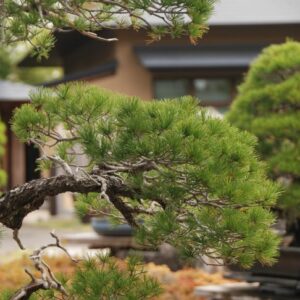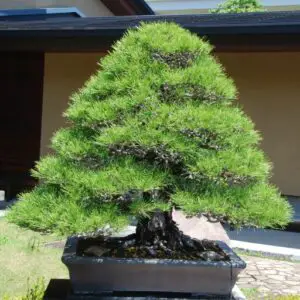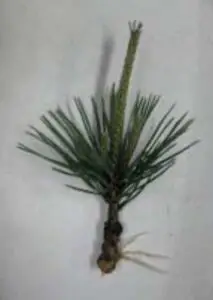You might be wondering whether Japanese black pine can be propagated from cuttings. The answer is yes with some reservations.
Japanese black pines can be propagated by cuttings but they are one of the hardest pine species for cutting propagation.
Can Japanese black pine grow from cuttings?

The basics of propagating Japanese black pine from cuttings
A cutting is a method of plant propagation using a section of a plant that forms adventitious roots (or shoots) and is frequently used to propagate plants including woody plants like bonsai species.
Japanese black pines (Pinus thunbergii) can surely be propagated by cuttings but it is well known, especially among bonsai enthusiasts, that they are one of the hardest pine species for cutting propagation. Growing from seeds is much easier and has a higher success rate when propagating Japanese black pines.
Success factors for cutting propagation
Difficulties aside, the success of propagating Japanese black pines from cuttings is affected by factors including-
- status of the parent tree, especially the age factor,
- cultivar,
- type of cutting (stem, leaf, root) and which part of the tree they are taken,
- promotion of rooting using plant hormones,
- type of culture medium, and
- environmental conditions (light, temperature, air humidity, soil moisture).
By far, the age factor has the most influence on the success of the propagation of Japanese black pines from cuttings.
Age of parent plant
In most plant species, the cuttings taken from the young growing phase root better than those from the adult phase. And this phenomenon is very much amplified for Japanese black pines.
This study shows (∗article in Japanese) that the average rooting ability of cuttings taken from two-year-old Japanese black pine was 75% whereas that of three-year-old dropped to 41%.
It is often said that Japanese black pines lose their rooting ability from cuttings after 5 years of germination. Of course, some of them may eventually take root if you use plant hormones or make a better rooting environment. But the success rate is so low that I don’t think it’s worth trying when the age of the parent tree is beyond 5 years old.
Cultivar
Different cultivars of the same plant species can have different rooting abilities due to variations in genetics. Although Japanese black pine does not have widely-recognized cultivars, trees taken from different regions have different rooting abilities.
This study shows (∗article in Japanese) that the rooting ability of two-year-old trees from 14 different regions of Japan varied from 55% to 98%. The rooting ability of three-year-old trees from 10 different regions varied from 19% to 78%
Since all the Japanese black pines look the same to human eyes, it is impossible to know where a particular Japanese black pine has come from by simply looking at it. But it is good to know that the rooting ability may vary depending on the “cultivars”.
Types of cutting
Usually, more roots are developed for the cuttings from the base portion of the tree than those taken from mid or top of the tree. This is because more energy and root-promoting substances are stored in higher concentrations at the base parts of the trees.
Also, rooting from adventitious shoots is better than that of normal shoots because adventitious shoots contain more growth hormones and are more resilient compared to normal shoots.
These phenomena are true for Japanese black pine as well, especially when the parent tree ages.
Use of plant hormone
Hormone treatment in general will increase the rate of rooting of Japanese black pine cuttings, though in part it depends on the parent trees’ original rooting ability. Using plant hormones to the cuttings of poor rooting ability has little or no effect on the rooting according to this study (∗article in Japanese).
Type of culture medium
Soil is an important factor for cutting propagation because the rooting is influenced by nutrients and water as well as oxygen contained in the soil. Common materials used in plant propagation include sand, peat, perlite, vermiculite as well as Akadama and Kanuma soil. Rooting medium should not contain organic matter and must be clean and sterile.
But what kind of growing medium is best for Japanese black pine?
On that matter, a scientific experiment was conducted to see the influence of the culture medium on the rooting of Japanese black pine cuttings. Scientists used two kinds of culture medium mixing vermiculite and Kanuma soil: one with 25% vermiculite and 75% Kanuma and the other with 75% vermiculite and 25% Kanuma.
The result shows that the rooting in the culture medium with a higher Kanuma percentage (75% Kanuma and 25% vermiculite) was significantly higher than the other one (33% vs. 16%). They are not definitively sure as to why it is but they think it is because Kanuma soil has better drainage than vermiculite.
As Japanese black pine prefers dry soil to moist one, growing media with better drainage may be a key to success.
Environmental condition
Temperature is considered one of the most important environmental factors in the success of cutting propagation. Pine trees grow best at temperatures between 64°F and 77°F (18°C – 25°C) and using an electric heating system to warm the growing media to this range is proven to have a much higher rooting rate.
Step-by-step guide to rooting Japanese black pine cuttings

Japanese black pine bonsai
Japanese black pine is an evergreen coniferous tree that is native to Japan and is highly prized for its strong yet graceful beauty. Though not the easiest way, one way to propagate this tree is from cuttings. This method is relatively simple and can be done with a few basic materials.
What you need
To propagate Japanese black pine from cuttings, you need;
- clean, sharp pruning shears,
- rooting medium (small grain Akadama, Kanuma, vermiculite, volcanic rock),
- container,
- plant hormone (optional), and
- clear plastic wrap (optional).
Growing medium
Recommended soil mix is;
-Akadama (small size): 70%
-Volcanic/river sand: 30%
The growing medium should have good drainage as well as water retention.
Step-by-step guide to rooting Japanese black pine cuttings
- The first step is to gather materials. The best season to do this is in early spring, from February to March. Select healthy, vigorous shoots with new winter growth from the base portion of the tree.
- Using the pruning shears, cut the base of the cutting just below a set of needles. The cuttings should be 2.5 inches (6cm) long. Put them in water to avoid dehydration.
- You can take out needles at the lower part of the cuttings, leaving needles at the top from one inch (2cm). Make two cuts at a 45-degree angle from two sides to increase the surface area for rooting.
- Dip the base of the cutting into rooting hormone, following the instructions on the package. This is optional but it helps to increase the rate of rooting.
- Before planting the cuttings, water the rooting medium thoroughly.
- Plant the cutting straight up deep into the rooting medium, 2.5 inches (6cm) apart from each other.
- Cover the container with a clear plastic bag or wrap to keep moisture in and frost out (optional).
Place the cuttings in a location with direct sunlight all day long. Water the growing medium and mist the cuttings at least once a day. Cuttings cannot absorb water before they take root and misting will prevent them from dehydration. Make sure they are moist but not waterlogged. Japanese black pines prefer dry soil.
You can put them in a greenhouse if you have one. Warming growing media with an electric heating system is known to increase the rooting rate.
Roots should begin to form in three months and the cutting will develop a good root system in about 6 months. They can be transplanted into a larger pot or into the ground after a year.

Cutting of Japanese black pine after 3 months

Cutting of Japanese black pine after 6 months
(Source)
—–
References
「松くい虫抵抗性クロマツの挿し木増殖技術」静岡県経済産業部
大山浪雄、「マツ属のさし木の発根能力とその増進法」、 林業試験場研究報告、森林総合研究所、1965-03、179 99-125




